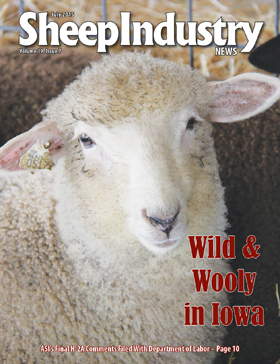
- July 2015
- President’s Notes
- H-2A Comments Come From Variety of Sources in Industry
- Iowa Gets Wild & Wooly at 11th Sheep & Wool Show
- Let’s Grow Grants Funded
- Market Report
- ASI Photo Contest
- Legislative News in Brief
- Trailing Festival Makes Plans
- Montana Program to Discuss Genetics
- ATHM Offers New Wool Exhibit
- Sheep News in Brief
- Wool News in Brief
- The Last Word
To View the July 2015 Digital Issue — Click Here

Section 32 Commodity Purchase Could Boost Lamb Prices
By Burton Pfliger
This month I’d like to discuss with you the conversations of the ASI executive board in requesting the U.S. Department of Agriculture to purchase lamb for the nation’s food banks, in order to strengthen live lamb prices for sheep producers.
Known as the Section 32 commodity purchase program of the USDA Agricultural Marketing Service, excess levels of commodities, including meats, are purchased every year to improve prices at the farm and ranch gate, as well as help feed needy families. The program is funded by tariffs on imported products and has been approved several times to move lamb out of the traditional market channel, helping to make the lamb supply more current, which therefore means better prices to producers.
The ASI executive board met this spring and approved a request for lamb purchases citing the record level of lamb in the cooler inventory, a huge upswing in imported lamb shipments and soft market lamb prices that have persisted to date in 2015. It should be noted that we always visit with lamb companies before making such a request.
In late May, AMS responded positively with as much as $10 million to be committed for lamb purchases. As of press time, the bid and award process were being spelled out with companies. I would anticipate – based on prior years – the bids will be for leg roasts and perhaps shoulder chops. Hopefully the bids will be taken in a quick manner so July and August processing can be underway to support the market prior to the fall run of lambs.
This year, ASI secured the support of Feeding America, a major sponsor of food banks that provide food for the needy. We appreciate the group’s letter of support.
The program benefits must be to the farmer and ranchers and those families actually receiving the food. It is not a program to support packers. In fact, several years ago a meat industry request included lamb and it was not approved. So the program really relies on organizations such as ASI and Feeding America.
The product is all processed under the supervision of a USDA meat grader, plans must be in place assuring it is always American lamb and the bid process competitive between companies supplying the meat. The product is then frozen and shipped to the prescribed food distribution centers located across the United States.
A couple of key arguments weigh into ASI consideration on these requests. First, it is probably the only national response to lamb-price drops or oversupply situations that we are aware of at this time. Second, USDA will buy protein every year, be it salmon, bison, beef, pork or chicken. Third, Agriculture Undersecretary Avalos and the officials of USDA AMS are very responsive to ASI with these program requests.
I have heard a few describe the request as a crutch to a supply and demand issue and I can see that view somewhat, however, I am not comfortable with ASI ignoring a tool that is the only response it has as a trade association to support lamb. And, the program has worked in prior years to increase live lamb prices.
A Section 32 purchase was the likely ignition of a tremendous jump in lamb prices in June 2002. I hope the purchase program does the trick this summer to pull the lamb market back to profitability and also that this discussion is of interest to you.
I am the fourth consecutive ASI president to request the program. I think if the lamb business is unable to balance supply and demand for more than one year at a time, it would justify the investment of company and checkoff funds to accomplish a more stable lamb market. The Section 32 program addresses the symptom, but not the root problem of volatile lamb markets.
A couple of additional topics on the lamb front include country of origin labeling with the U.S. House of Representatives committee on agriculture passing legislation to retain labeling of lamb. Legislative direction on COOL for lamb dates to the Farm bill of 2014, when labeling was hotly debated. Beef, pork and poultry producers have many conflicts and opposing views, as is evident in the years of wrangling their industries have had over COOL. That has not been the case for lamb.
ASI policy has supported identification of foreign lamb for two decades and the agriculture committee leadership recognized this with their legislation to retain lamb labeling. The U.S. Senate will follow later, and I suggest we stay consistent with our policy and ask our senators to retain labeling for lamb.
As you read this spring, ASI has been very active on the reauthorization of Mandatory Price Reporting for Lamb in Congress. In fact, the U.S. House of Representatives version to extend the authority past September 2015 includes statutory language on lamb, so USDA can gather more purchase and price information on lamb and lamb meat purchase and sales.
We addressed thresholds that dictate if a company is large enough to report on both American and imported lamb, and hopefully, our language will also allow reporting by the lamb cooperative, which until now has not been gathered by USDA. We believe the cooperative wants to participate, but definitions at USDA have not provided for gathering it.

